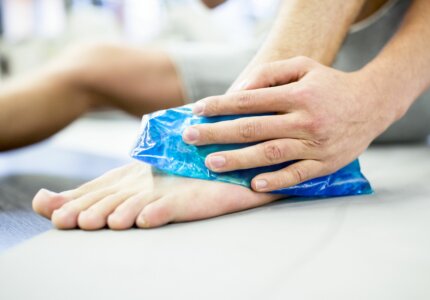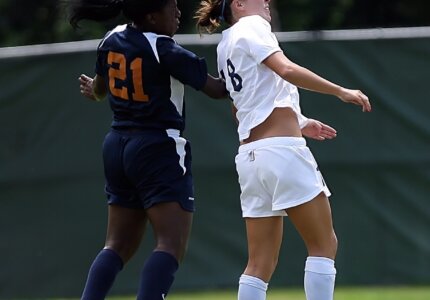🎾Insights from WTA Stars Demi Schuurs & Nicole Melichar-Martinez
The thirst for, and popularity of tennis has seen it become one of the fastest growing sports in Australia, and saw a whopping 22% increase in participation in the USA. These figures are bound to surge off the back of Netflix’s highly successful tennis documentary Break Point. All of this is wonderful for the sport of tennis however, a gulf remains between both the men’s and women’s competition, and between singles and doubles in terms of media coverage, public awareness and prize money. This was no more evident than in the Netflix series where doubles, especially women’s doubles received limited to no airtime.
To raise awareness of doubles, especially women’s doubles, and of the challenges female athletes and tennis players face, Melbourne city sports chiropractor Dr. Shannon sat down for a chat with two of the brightest stars of women’s doubles, Demi Schuurs and Nicole Melichar-Martinez.
📉 The Visibility Gap
When tennis fans are asked “who is your favourite player(s)?” The answers usually begin with the big male stars, Roger, Rafa, Novak, Alcaraz, Kyrgios, then come the big women players Iga, Serena, Ons, Gauff, but rarely will fans name any doubles players. This is likely tied to the lack of TV and media exposure fans get to doubles tennis, with the great irony being that many recreational players, particularly older players as Demi points out “like doubles so much as they play doubles themselves”. This raises the question, “if people enjoy playing doubles, why aren’t they watching more doubles?”
Both Nicole and Demi are in lockstep with their view here with Nicole saying, “I think overall singles has always been the big show and the main priority. At the end of the day people want to watch the big stars and who they know”. With Demi further adding “singles is much bigger because of the money, the TV coverage and tickets (sales)”. The priority given to singles tennis is no more evident than in how matches are scheduled as Demi goes on to say, “if there is a doubles game on (scheduled to play) the tournament (officials) will put on a singles game first, especially if the players are famous”.
It is clear speaking to both players that the battle for increased coverage and attention of women’s doubles isn’t between men’s and women’s doubles, but more a battle between singles and doubles. This is compounded somewhat by the current strength of the men’s game which is driving crowd numbers, as is clearly visible at matches with big men’s stars like Alcaraz and Kyrgios. As Demi points out the women’s game has “many good players, but they aren’t that popular to draw the crowds like Djokovic, Kyrgios. We miss a big star like the Williams sisters, or Sharapova right now and this is also hurting women’s doubles”.
👉 Find out how Melbourne sports chiropractor Dr. Shannon manages tennis injuries.
🧠 Challenges Female Athletes Face

Although the challenge for women’s doubles comes from the strength of singles, in particular the men’s game, female athletes and tennis players still face challenges their male counterparts do not, and in many cases face challenges fans are not cognisant of. There are the physiological differences between men and women, where female players have to grapple with a choice between starting a family or having a career; or the challenges the menstrual cycle brings. With Demi highlighting that “women have to wear white at Wimbledon when they are having a period (and this) is something men don’t have to deal with, but for women it is a worry”.
Body Shaming or Just Good Looks
Furthermore, female players and athletes are subject to more commentary about their physique than males, where attention is more often paid to how attractive a player is. A point Nicole reinforces, saying “women are extremely strong and powerful, and are incredible athletes who don’t get enough credit for that”, instead if “a woman isn’t ripped she gets shamed”. This can create psychological challenges for female players including a drive to be thinner, which can lead to inadequate nutritional intake tipping the athlete down a dangerous cascade called “relative energy deficiency in sport (RED-S)” resulting in low bone mineral density, eating disorders, amenorrhea among a host of other potential negative health related problems for female athletes.
Physiology and physique are not the only challenges female players face, with different sign-in rules for men and women, preferential court treatment where, Nicole’s Wimbledon doubles final was played on court 1, while the men’s doubles were played on centre court. Additionally, there are still disparities in prize money, which both players agree is a problem more so in non-Grand Slam events. Both men and women play the best of 3 sets at tournaments outside the Grand Slam events, requiring an equal amount of preparation, time and energy justifying a more equitable solution to the current disparity.
The Challenges Doubles Players Face
As both players have raised, the greatest challenge for doubles is to step out from the expansive shadow singles tennis casts. On a higher level, doubles is rarely broadcast on TV, with little media attention given to doubles players or their stories with Nicole imploring “we rarely even get interviewed from the media, so there’s no chance for tennis fans to even get to know us”.
Moreover, Nicole points out that doubles players “do not get to practice on the big courts leading up to an event. Sometimes it is difficult to even practice on-site, we have to go off-site.” Furthermore, those practice times are usually at less than desirable times such as early morning or late afternoon”.
Additionally, as Demi explains, lower and mid ranked doubles players are at the mercy of singles players, where at sign-in for a tournament, “singles players can come in and kick out the doubles player(s) who are mid field”. Demi goes on to say that often those singles players are only playing doubles at that tournament to help them find their rhythm for their singles matches, especially if they are out of form or returning from injury.
Together these all create a raft of obstacles doubles players need to navigate that most tennis fans will be oblivious to. Leading into the question of what can be done to boost the profile, media coverage and equality in terms of court access, sign-in rules, prize money etc of women’s doubles.
👉 Interested in learning more about injury prevention in tennis? Purchase a copy of Melbourne sports chiropractor, Dr. Shannon’s book “Injury for tennis players: A comprehensive guide to staying injury free on the court” today.
📣 How Fans Can Drive Change
Changing the narrative on women’s doubles and doubles is no easy fix, requiring all stakeholders involved including the fans. It needs to start with the media, helping to follow and craft the characters and rivalries they do for singles tennis. Nicole would like to see the media “follow our stories and paint us in a picture that fans really want to engage with us!”. With Demi reinforcing the need for improved media coverage, “we deserve more attention, (and) promotion when compared to singles”.
To create that attention and buzz requires star power, as it is the case in singles tennis. That star power could come from a big singles star playing doubles, as was the case with Nick Kyrgios at the 2022 Australian Open. Likewise, if given enough media attention and coverage, it could come from within women’s doubles tennis where there are a host of players worthy of that spotlight including both Demi and Nicole.

Driving change also requires unity from within, and if female players are to reduce the prize money disparity that still exists at some tournaments, singles and doubles players need to work together. With Demi indicating that, if only some singles or doubles players chose to work together and not all, there is no chance of any change. But if both work together, there is a real chance for doubles to start getting more deserved attention, including better TV coverage and promotion, as well as more doubles matches being scheduled earlier in the main stadium courts, as Nicole would like to see.
Finally, it is the fans who hold the greatest sway because if the fans start packing out stadiums and blowing up social media, the media and organizing bodies will start to listen. As Demi says, “if the fans are happy, they are more likely to promote it (women’s doubles) which will have a snowball effect; if it’s more popular, more people attend, meaning more coverage, more money and the circle goes around to improve women’s tennis”. Nicole reinforces this message, “fans need to fill up doubles matches anytime they are on, to show the organization (WTA/ATP) that people really are doubles fans and want to see it”. The message couldn’t be any clearer from both women, that if the fans speak up, they will be heard and that will be the catalyst for change. A change both women’s tennis players and doubles players are well deserved of.
Having worked with both Demi and Nicole, Dr. Shannon can attest to how hard female tennis players work on and off the court. Making it more unthinkable that female tennis players, and doubles players still face such disparities when compared to male players and singles tennis. It is for this very reason, Dr. Shannon chose to write this blog to highlight the struggles female doubles players and female athletes face, to raise awareness with the public, to start the conversations, and to work towards a more equitable playing field for female tennis players and athletes.
👉 Read our post on upper limb injuries in elite tennis players for more on the physical toll of the sport.
📍 Shannon Clinic | Melbourne CBD
Located on Collins Street, Shannon Clinic supports elite athletes and active professionals with evidence-based chiropractic care. Whether you’re a tennis fan or a player—we’re here to help you move better and advocate louder.
If you would like to book an appointment at the Shannon Clinic – Melbourne Chiropractic and Sports Care with either Dr. Shannon or our former pro tennis player turned remedial massage therapist Paula Pena you can book below.



